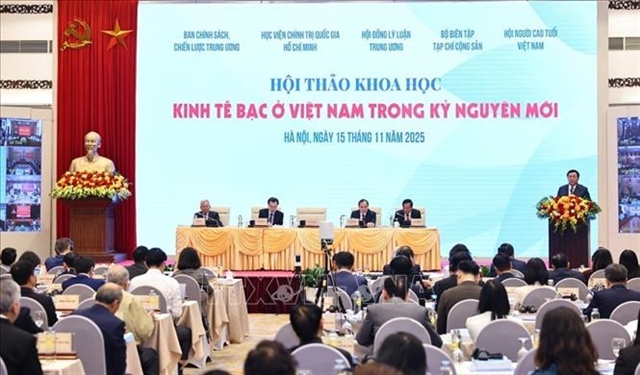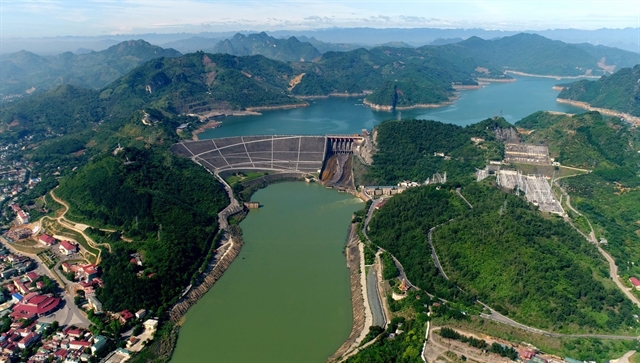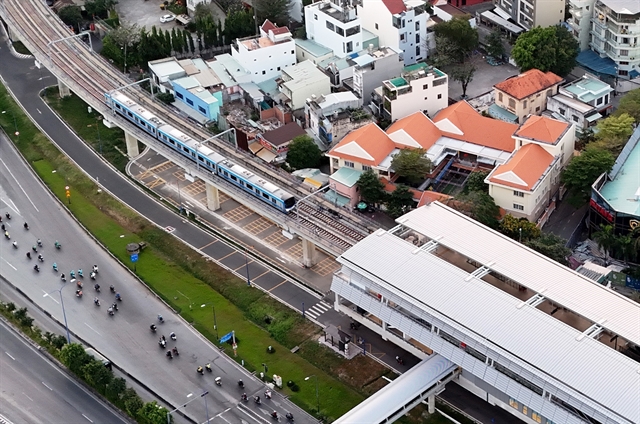 Economy
Economy

 |
| Hòa Bình hydropower plant. — VNA/VNS Photo |
HÀ NỘI — Việt Nam’s construction sector is pushing to deliver more mega, world-class projects, boosting its global reputation and ushering the nation into a new era – the era of the nation's rise.
According to the Ministry of Construction more than 120 large-scale projects of national significance have been completed over the past four decades. Many of them feature innovative structural designs, new construction techniques, and cutting-edge technologies, some introduced in Việt Nam for the first time or holding regional importance.
Iconic projects include the Hoà Bình, Yaly, Sơn La, and Lai Châu hydropower plants; Cần Thơ Bridge, Dung Quất Refinery, Bãi Cháy Bridge, Cái Lân Port, Hà Nội-Hải Phòng Expressway, Vũng Tàu 4 thermal power plant, HCM City-Trung Lương Expressway, Nhật Tân Bridge, Hải Vân and Đèo Cả tunnels, and Nội Bài and Tân Sơn Nhất international airports. More recently, the North-South expressway, and Nhổn-Hà Nội station and Cát Linh-Hà Đông urban railway lines have stood out.
Speaking at a recent meeting on accelerating infrastructure development, Prime Minister Phạm Minh Chính commended Vietnamese contractors for their pivotal role in these achievements.
Nguyễn Quốc Hiệp, chairman of the Vietnam Association of Construction Contractors (VACC), said that over the past two decades, Việt Nam’s construction market had been dominated by companies from Europe, the US, Japan, and South Korea, which had been involved in major projects, either directly or indirectly.
However, domestic companies had gained valuable expertise and project management skills from top international contractors through joint ventures as partners or subcontractors. Vietnamese firms had over recent years taken the lead in major domestic projects like the North-South Expressway, the Landmark 81 skyscraper in HCM City, the Lego Group’s manufacturing plant in Bình Dương Province, and Long Thành International Airport.
“These tangible results serve as the foundation for the Government’s strong confidence in the growth of domestic contractors, especially when it comes to entrusting Vietnamese enterprises with major projects,” Hiệp said.
“If provided with supportive mechanisms, domestic firms are fully capable of delivering large-scale, internationally benchmarked projects such as the North-South high-speed railway".
 |
| A bird's eye view of Hạ Long City. — VNA/VNS Photo |
At present, Việt Nam’s construction market is considered a “lucrative opportunity” for international contractors. Therefore, promoting construction localisation is a long-term vision to pool domestic resources and enhance Việt Nam’s economic competitiveness.
To empower domestic enterprises to lead infrastructure projects and compete internationally, the sector and construction firms must fulfil six key tasks outlined by the Prime Minister in October 2024:
First, there must be a deeper recognition of the importance of key national projects to creating new development spaces, which help establish industrial zones, urban areas, and service hubs, increase land value, improve mobility for citizens, and reduce logistics and production costs, ultimately enhancing the competitiveness of goods and the overall economy.
The second task is pooling and diversifying resources from the State, individuals, businesses, direct and indirect investors, and public-private partnerships to develop strategic infrastructure in a way that harmonises their benefits.
Third, it is necessary to advance and transfer cutting-edge technology, train quality human resources, and improve smart-oriented governance capacity in business operations and project implementation.
Another task is revising and fine-tuning institutions related to site clearance, construction materials, technical standards, processes, bidding, and project contracting to ensure streamlined, favourable conditions and address institutional bottlenecks.
The fifth lies with upholding the spirit of self-reliance and internal strength, leveraging state support and international partnerships to foster growth.
Sixth, it is a must to promptly resolve institutional, resource, and workforce challenges to accelerate rapid and sustainable development of domestic construction firms and contribute to national progress.
Experts predict that the next decade will offer ample growth opportunities to the domestic construction industry. In recent years, the country’s GDP has consistently exceeded expectations, maintaining a robust growth rate between 6 per cent and over 7 per cent. The construction sector has played a key role, contributing 11-12 per cent of GDP, an indication that Việt Nam still has substantial room for development in housing and urban infrastructure compared to other emerging economies in the region.
With vast potential and numerous challenges ahead, Vietnamese contractors are well-positioned to rise to new heights. This momentum is driving the construction industry forward.
According to Chairman of Hoà Bình Construction Group Lê Viết Hải, Vietnamese contractors have not only excelled in residential and high-rise construction but have also outperformed regional firms in general contracting and project management.
 |
| Metro line 1 – the first of the city’s eight planned urban railway projects – began commercial operations on December 22, 2024 and was officially inaugurated on March 9, 2025. — VNA/VNS Photo Hồng Đạt |
Even globally renowned Japanese and South Korean contractors have acknowledged the remarkable progress of Vietnamese firms.
Hải said that 30 per cent of his group’s projects fully embraced Building Information Modeling (BIM), an international standard for managing construction assets throughout their lifecycle, compared to just five per cent for South Korea's Hyundai Engineering & Construction.
The Vietnamese Government is ramping up investments in transportation infrastructure, allocating around VNĐ470 trillion (US$19 billion) from 2020-2025 and nearly VNĐ900 trillion by 2030.
This plan aims to expand urban spaces, develop compatible and modern technical and socio-economic infrastructure, and presents an opportunity for domestic enterprises to accelerate their growth.
To capitalise on these opportunities, especially with the coming high-speed railway project, Vietnamese contractors must adopt a forward-thinking approach.
Now is the time for them to invest in equipment, train engineers and workers, and master construction technologies, paving the way to become primary contractors for major national transport projects. — VNS




